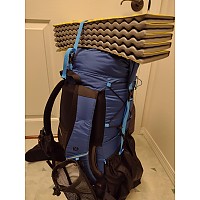Hilleberg Anjan 2 GT

A solid, wind-resistant tunnel tent with a huge vestibule, lightweight for all the living space it offers. Tradeoffs associated with the tunnel tent design mean that its best use is in open, windy, and rainy environments.
Pros
- Top quality materials and construction
- Excellent wind tolerance
- Outer tent first/only pitch
- Huge vestibule
- Good weight-to-space ratio
Cons
- Single front entry
- No roof level ventilation
- Condensation on acutely sloping foot end
- Non-freestanding (can’t be turtled for drying floor)
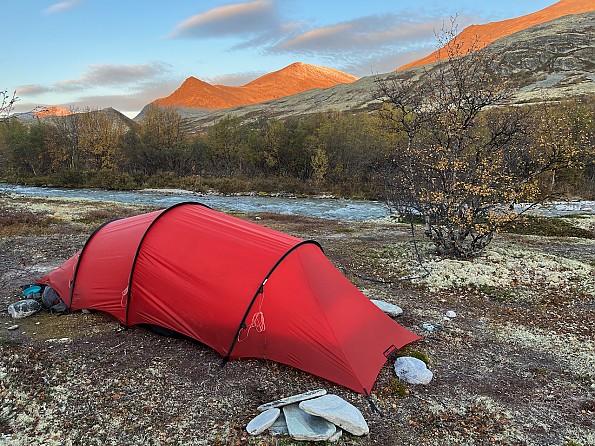
When my wife and I hiked Sweden’s arctic to subarctic, 450 km Kungsleden in summer ’23, we joined up for a while with Maria and Amanda, a fast and efficient Swedish mother-daughter team. They had an Anjan 2 GT, so we were able to inspect it inside and out, without actually sleeping in it. It offers a lot of space, including a huge vestibule, and high-quality materials, design, and construction, in a surprisingly light package.
So we decided to spring for one ourselves, looking ahead to some autumn hikes in Norway and a planned visit to the Pacific Northwest this summer. It took some learning to make friends with this tent and accept some of the tradeoffs vis-a-vis a lightweight freestanding tent. It’s a great choice for Scandinavian and similar conditions—above treeline or open forest where you are exposed to wind, lots of cloudy and rainy weather, and cool to cold nights even when the sun doesn’t set.
Top quality
Hilleberg has a well-deserved reputation for top quality materials and construction. The Anjan is in Hilleberg’s three-season Yellow Label line-up, where the emphasis is on weight saving while still maintaining quality. The outer tent is made of triple-coated 20D ripstop nylon, coated with two layers of silicon two layers on the inside and one on the outside. That's a lighter grade than in Hilleberg's all-season tents but still feels slightly sturdier than some of the other lightweight tents I have used.
The bathtub floor and pole sleeves are triple PU-coated 70D nylon, beefy enough that I’m willing to forego a footprint if I can’t afford the extra weight. The solid walls of the inner tent are DWR treated 10D ripstop nylon, while the door and rear window are ripstop mosquito netting, again much sturdier than the rather fragile netting used in other lightweight tents. There is no second, solid door or window cover to fully seal up the inner tent, presumably to save weight on fabric and zippers.

I am especially pleased with the zippers, often a weakness in outdoor equipment of all kinds. I haven’t found the specification on the website, other than that they are YKK, but both the vestibule zipper on the outer tent and the inner door zipper look to be YKK#5 coil, tougher than the lighter zippers that typically fail sooner or later on other lightweight tents. The outer zipper has a stiff (Hypalon?) rain flap that won’t jam the zipper like the soft nylon rain flaps on many other tents.
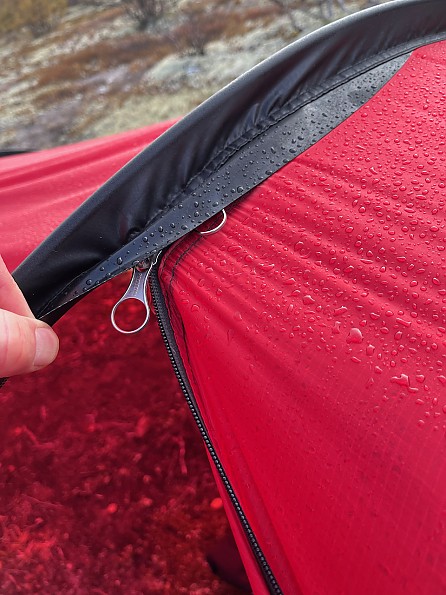
The sturdy 9mm DAC NSL poles come in two lengths, a longer one for the middle of the tent above the inner tent door and the other two for the foot end and vestibule. All the pole sections except for the butt ends are the same length, and Hilleberg includes a full section (20g) and a repair sleeve (11g) in the pole bundle. The poles are not pre-curved but bend naturally into a semicircle in the pole sleeves and bundle into a straight package for rolling and storage.
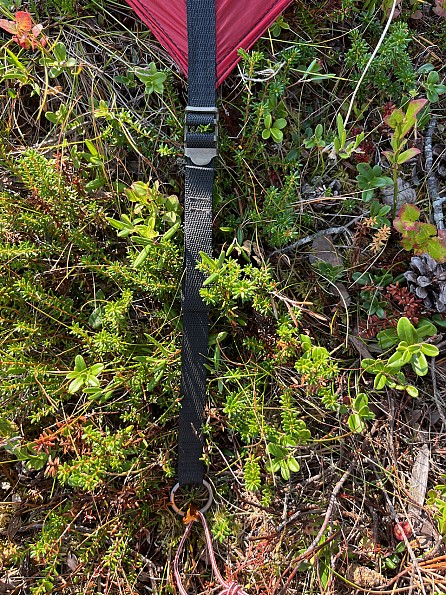
The materials used in dozens of other details such as adjustable webbing straps for the pole and peg attachments, reinforced seams at key stress points, beefy guy lines, and light but tough Y pegs, are all in line with Hilleberg’s high-end philosophy.
The tent comes in an oversized stuff sack made of the outer tent material. For a more compact bundle, we carry ours in a smaller (ca. 45 x 15 cm / 18 x 6 in) and tougher ripstop nylon stuff sack that can be strapped to the bottom of a pack in overflow mode.
With all pegs and the repair sleeve and our chosen stuff sack, but leaving out the repair section (a repair job better done at home) I get a total weight of 2155 g (4 lbs 12 oz), about 45g/1.5 oz under Hilleberg’s estimate. We went ahead and bought the 246 g (8.7 oz) footprint, made of the same material as the floor, to take along when we can afford the weight or to use as a floor when using the outer tent only (unlikely in our case).
Inner and outer space
The Anjan models fall toward the smaller and lighter end of Hilleberg’s extensive lineup of Scandinavian style tunnel tents. The two-pole Anjan has a small, low vestibule at the head end, while the Anjan GT adds an extra pole for a massively expanded vestibule, especially in terms of useable volume—your friend in rainy and windy weather.
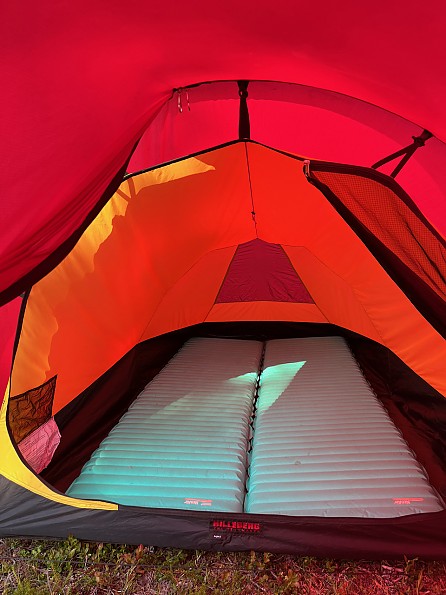
Most lightweight two-person tents are “tight for two, spacious for one”. That’s generally true here. The Anjan’s 220 cm (86") length should give a tall guy like me (190 cm / 6' 3") plenty of room, but the acute slope of the inner tent at the foot end cuts into the usable length, so with my little pillow up near the door I find that the foot end of our two-person quilt inevitably comes in contact with the back wall of the tent. (Even this ca. 175 cm tall Swedish reviewer seems to find the Anjan a bit short for full comfort). The Anjan’s 130 cm (51") width at the head end, tapering to 110 cm (43") at the foot end, gives room for two full-length, 50 cm (20") wide mattresses with a little room left over at the sides for gear, especially for intimate couples with conjoined mattresses.
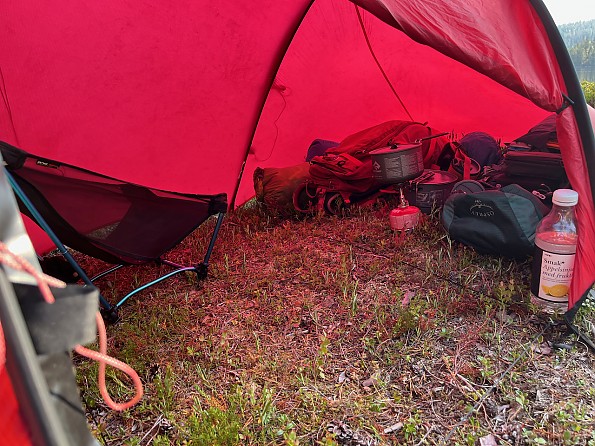
Those measurements give a total area of 2.6 m2 (28 ft2). At a nearly equal 2.5 m2 (26.9 ft2), the generous vestibule can accommodate a pile of gear with room left over for cooking (or maybe a wet dog or two) in inclement weather.
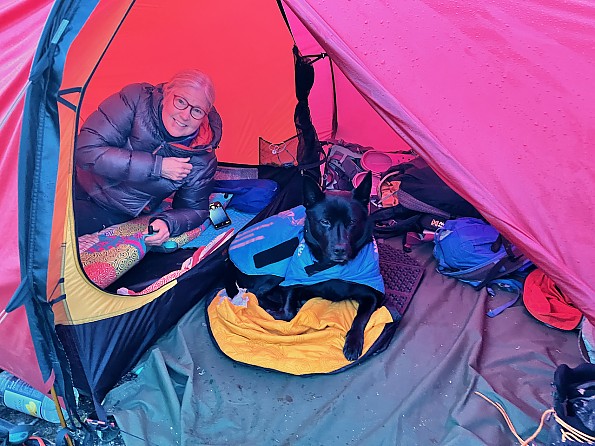
The maximum height of the inner tent at the head end is 80 cm (31")—as a tall guy I wouldn’t mind a few cm more there—while the max height of the vestibule, just outside the door, is a full meter (39"). If I have to cook in the vestibule, that’s plenty high enough for me to sit in my ground-level backpacker chair with my back to the door and my stove to one side.
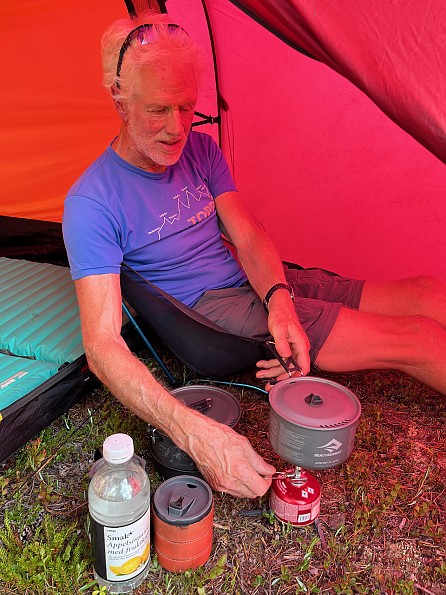
The inner tent comes with a clothesline running between the two poles. Having some doubts about sharing our living space with wet, smelly socks and t-shirts, we haven’t used it much.
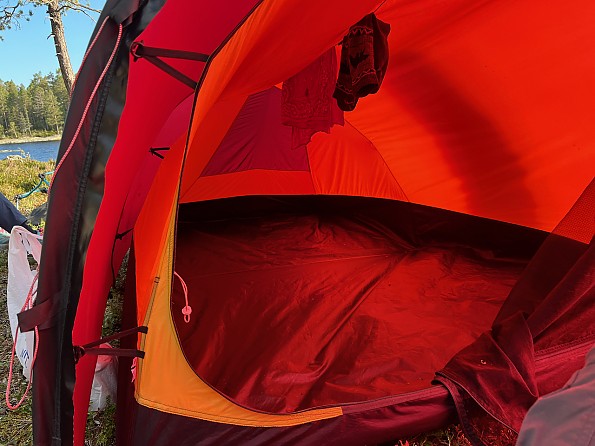
With Hilleberg’s outer-first pitching method, the poles run through sleeves in the outer tent, rather than having an outer tent that fits over the inner tent. One end of the poles blind-ends in the pole sleeve, the other fits into a plastic cup with an adjustable strap so you can crank the sleeve tight over the pole.
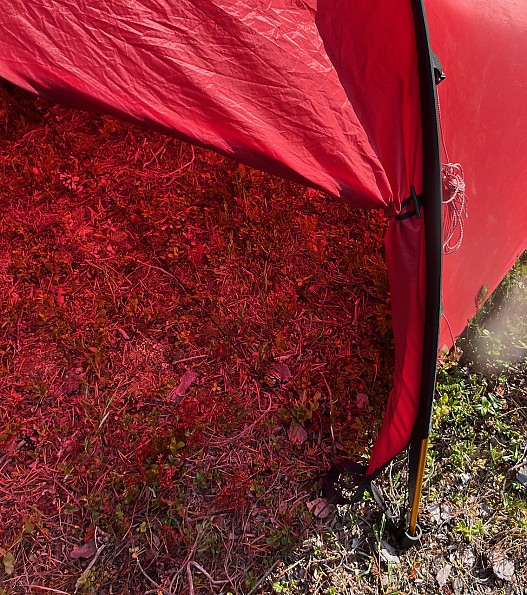
The inner tent is suspended from the outer tent by elastic loops with simple toggles that mate with rings hanging from under the pole sleeves on the outer tent—seven per pole so 14 in all, plus six more for the floor.
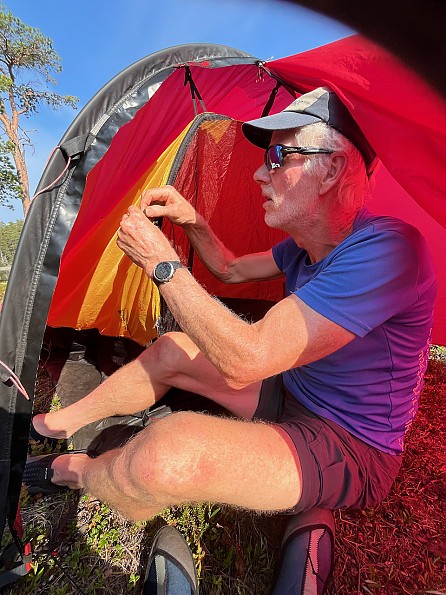
Hilleberg doesn’t provide any mechanism for tightening up the inner tent, so that it hangs somewhat loosely. One consequence of this is that the stash pockets on the tent walls by the sleeper’s heads are also somewhat loose, so that any weight in them tends to pull them in and down, encroaching a little bit on living and sleeping space. Some more pockets for stashing small items might be nice, but the problem would be worse with any pockets placed further up on the walls or further from the poles.
Having used various dual-side entry tents, I find it hard to go back to a single front entry. Yes, it’s one less zipper to potentially fail, but in-and egress is just not as smooth. If you want to go out for midnight pee, with your camp shoes stashed in the vestibule just outside the door, you have to do an awkward 180˚ butt-spin, swinging your legs over your sleeping partner or with knees drawn up against the tent wall, to get your feet out the door and into your shoes. The alternative is to crawl out on hands and knees and deal with shoes out in the vestibule. With side entries, an easy quarter-turn on your butt will get you both in and out. The single entry is a necessary consequence of the tunnel tent plus roomy vestibule design, which in other respects is weight-efficient and wind-resistant, but certainly not the last word in tent design.
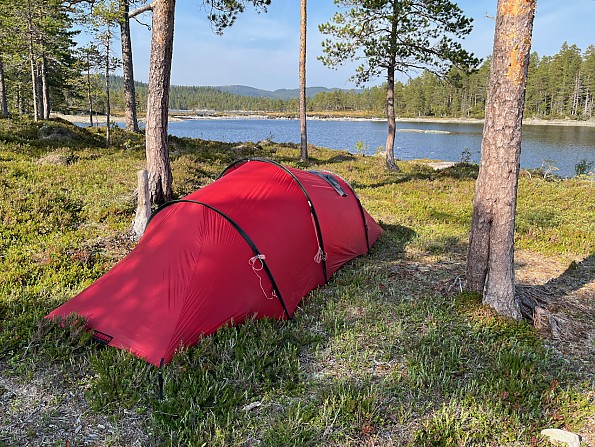
Another consequence of the tunnel + vestibule design is the overall length—at 410 cm (160” = 13.3 feet!), the Anjan GT needs a long tent site, a limitation that we have already run into on a couple of the nights that we have used the tent so far. A tent with generous side vestibules might also run into space limitations, so it’s a tossup as to which configuration works better.
Pitching in
Like Hilleberg’s other tents, the Anjan can be pitched outer tent first or fully assembled with the inner tent, and even footprint, already in place. That gives you a chance to keep the inner tent dry when pitching in rain, at least if it was put away dry. But it comes with some tradeoffs.
First, while the pole sleeves can help give a tight, bombproof pitch, running the poles in and out of them can be a pain, especially when wet. On the way in they can hang up on the sleeve, and on the way out the sections can pull apart so that they are even more difficult to get out. Hilleberg recommends inserting the pole about halfway through the sleeve, then pulling the rest of the sleeve over it before pushing the pole through the rest of the way. It’s also best practice to push rather than pull the poles out so that the sections don’t separate. A little practice with this goes a long way, but pole sleeves can still be a hassle in cold, wet weather when patience wears thin.
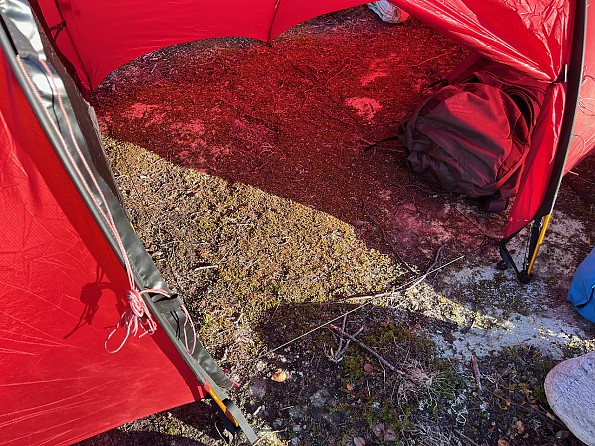
Second, to allow outer tent-first or outer tent-only pitching, there are cords connecting the ends of the pole sleeves for each pole, to keep the ends of the pole from spreading apart. Not a problem if the outer tent or assembled tent was carefully folded and rolled when put away, but otherwise, like the guy lines, they tangle up the outer tent and require time and fiddling to sort out. Not nice in rain and wind. Three of these cords, one across the vestibule entrance, a second in front of the inner tent entrance, the third about halfway down the length of the vestibule, all a few cm above ground level, can be tripwires when going in or out or shuffling gear in the vestibule, for example when sleepily going out for a midnight pee.
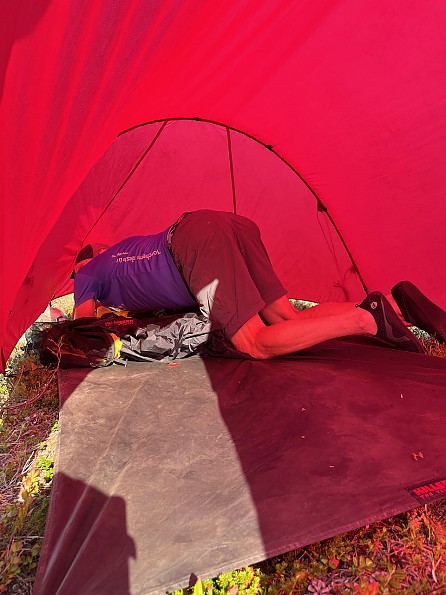
Third, clipping the inner tent at the foot end more or less requires getting down on elbows and knees to reach those low back corners. Not so nice on wet or rough ground. It’s probably best practice to have the tent pre-assembled when you leave home, and try to keep it that way throughout your trip. If you have managed to keep the inner tent more or less dry overnight but the inside of the outer tent is soaked with condensation, you’ll be tempted to take the inner out in order to keep it dry, rather than roll it up inside the wet outer. But that means more time and more fiddling, in the morning and for the next time around at the end of the day. It’s probably more efficient just to let the inner tent get wet and roll up the tent in one piece, and hope it dries from body heat the next time around. Either way, if the tent is at all damp when you get home, it’s a good idea to separate the inner and outer so that they dry thoroughly. It’s possible and a good idea to reassemble the tent before the next outing, otherwise it’s back on elbows and knees the next time you put the tent up.
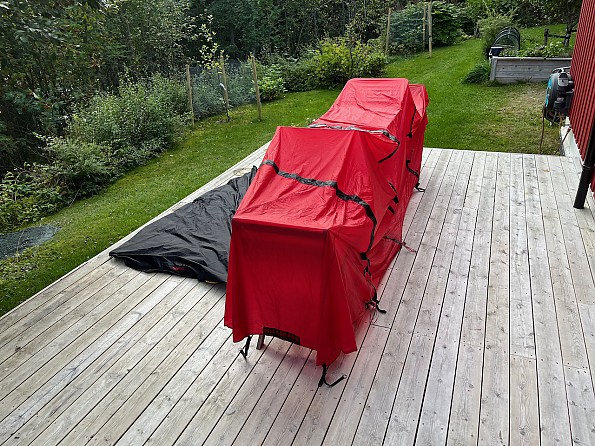
Finally, because the tent is not fully or partially freestanding, there is no good way to “turtle” it floor-up in the sun to dry the floor, a common practice with dome and other more or less freestanding tents.
Most of these tradeoffs can be dealt with by developing good routines for pitching, collapsing, and rolling the tent as recommended by Hilleberg, but that can be time-consuming and take more time in windy, rainy, and cold conditions. I suppose that’s true of any tent, but between running poles in and out of wet pole sleeves, coiling and securing guy lines, and folding and rolling to prevent tangling, this tent can require a lot of fiddling. These are more or less necessary trade-offs for the wind resistance and functionality of a solid tunnel tent.
Blow wind blow
We have spent a few nights in the Anjan in moderate, gusty winds, enough to be confident that the Anjan is bombproof in high wind, provided that it is pitched with the head end into the wind (as recommended by Hilleberg) and fully guyed out. I have been impressed at how little the tent flaps in the wind when it is guyed out—all-night flapping is not a recipe for a good night's sleep.
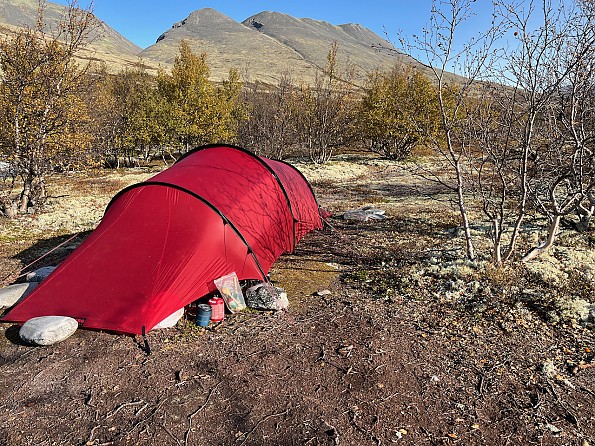
In mild conditions the tent can be pitched with as few as four pegs, two at each end, but for a taut pitch I usually like to use six more to peg out the floor at the ends of the poles. It takes six more to peg out the guy lines on each side of the three poles, for a total of sixteen pegs for a full bombproof pitch. They’re nice pegs, but that’s a lot of pegs to find solid placements for on difficult ground, and they weigh about 10 grams each. If you’re camping in trees or other wind-protected places, you could probably cut back to as few as four pegs and maybe even remove the guy lines to save a couple hundred grams.
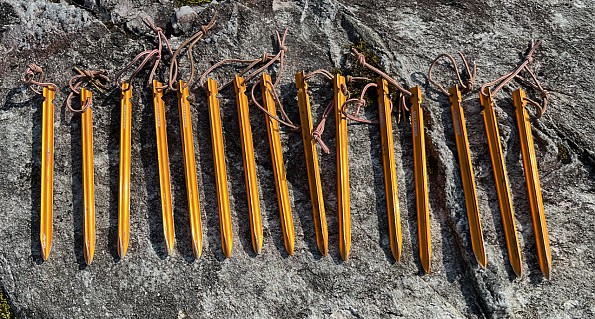
All of the guy lines do double duty by attaching to the tent at two different points, with line tighteners at the upper ends so it takes minimal fiddling to balance the pull of the two lines, a very nice system overall.
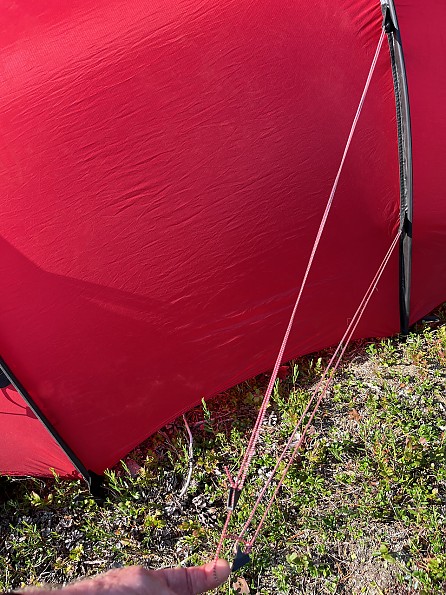
One thing though—if not properly coiled and secured when you put the tent away, the guy lines can easily get crossed and tangled when pitching the tent the next time. This means that even if you are taking the tent down in windy, rainy, or cold conditions it can be worthwhile to take time to stow the guy lines so they don’t get tangled when you have to pitch again. I just shorten them up, double them over, and tie off the bundle with a loose overhand knot. None of this fiddling is necessary if you do a minimal pitch without using the guy lines at all.
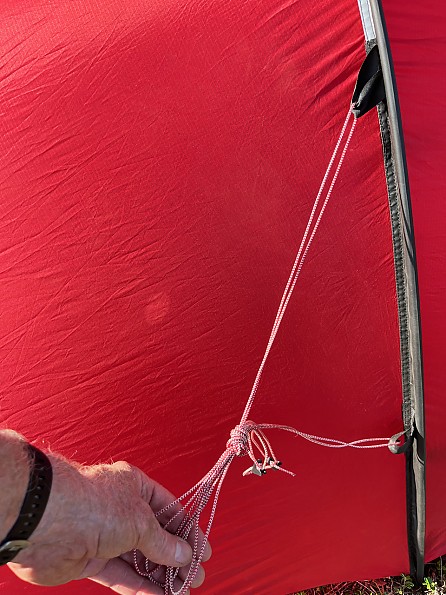
Ventilation and condensation issues
Unlike Hille’s all-season tents, the Anjan does not have roof level vents. Instead, the lower edge of the outer tent is cut to curve away from the ground between attachment points, a so-called catenary cut. Hilleberg provides a nice diagram with double headed blue arrows around the edge of the outer tent, suggesting that this provides adequate air exchange to limit condensation on the inside of the outer tent and bathtub floor.
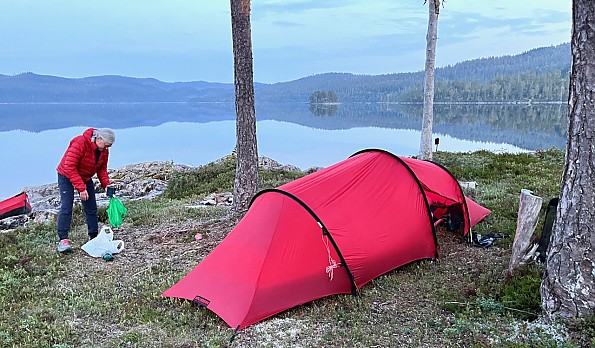
I started out skeptical, but at least when camping where there is breeze, which often also helps prevent dewfall, there is adequate air movement to keep the inner surface of the outer tent dry. It’s in rain or when there is heavy dew that condensation is hard to beat, in any tent. I’ve never met a tent, even those with roof vents, that didn’t have some condensation build-up on the outer tent in cool moist conditions. The amount of water exhaled by two sleeping humans depends on the temperature and relative humidity of the air they breathe but can amount to tens of milliliters per person per hour, so maybe hundreds of ml (one or more cups) over an eight-hour night.
A tent that is sealed up for a long rainy night will fill up with a bubble of warm moist air that is trapped by the fly or outer tent. Roof vents can let at least some of that air escape, limiting the total amount of condensation. I’m not fully persuaded that ground level venting allows as much moisture out. We have experienced significant condensation on dewy nights, even with the vestibule door parked open.
One consequence of this happens at the foot end of the tent. Under the acutely angled outer tent, the bathtub floor also angles in over the sleeper’s feet and so comes in contact with the foot of a sleeping bag. Because it doesn’t breathe, condensation can collect on that sloping bit of the bathtub floor, so the foot of the sleeping bag gets a bit wet. Hilleberg’s own video recognizes this problem and suggests some (fiddly) ways to reduce condensation. It can help to flip the foot end of the sleeping bag over to give it some time to dry from residual body heat while you make breakfast.
Condensation problems are not unique to the Anjan but may be exacerbated by the lack of roof vents and acutely sloping foot end. Maybe a couple short, sewn-in struts to make the bathtub floor more vertical at the foot end (but the what do you do about the outer tent)? And this user would like to see one or roof-level vents to let warm, moist air out.
Thermoregulation
“Climate is what we expect, weather is what we get.” (Mark Twain).
We went to the North Cascades prepared for cool, rainy weather, but instead we got relentless, hot, dry weather. Fully pitched with the outer tent nailed down at both ends and camping in trees with little air movement, the Anjan becomes a heat bubble, even with the outer tent pulled open. After a few nights of this I worked out a way to roll up the ends of the outer tent to allow some air in via the door and window, by using the guy lines on the poles to tension the middle part of the outer tent. Rolling up the foot end is suggested in the 13 minute (!) how-to-pitch video on Hilleberg’s web site, but I also worked out a way to roll up the vestibule for even more fresh air. It’s possible to roll up just the front end of the vestibule, but to fully pull it back you have to remove the vestibule pole, so in the event of a midnight rain shower it will take some time and hustle to get closed in again.
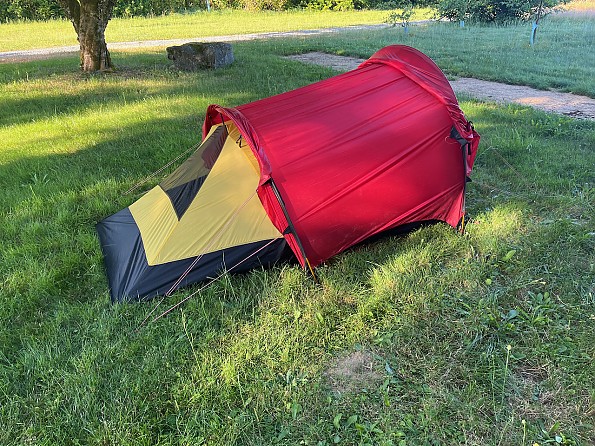
The Anjan doesn’t come with the option of pitching the inner tent only, but Hilleberg will be happy to sell you some accessory pole holders, presumably the same plastic cups that hold the free ends of the poles on the outer tent, to make this possible. If it rains unexpectedly, the inner will have to be collapsed to free the poles in order to erect the outer tent.
Hilleberg will also be happy to sell you a mesh inner tent for more air movement or full stargazer mode. Maybe it’s possible to special order an Anjan with a mesh instead of solid canopy, which might be a good choice for warmer environments. Surprisingly. the mesh actually weighs a tiny bit more than the solid canopy. But as delivered, the Anjan is outfitted more for Scandinavian conditions, cool and sometimes wet, and often windy above the low treeline—at worst, horizontal rain.
Word
I'm giving the Anjan 2 GT a high score because it is excellent for what it is—a lightweight tent that performs at its best on its home peninsula (Scandinavia) and in similar environments.
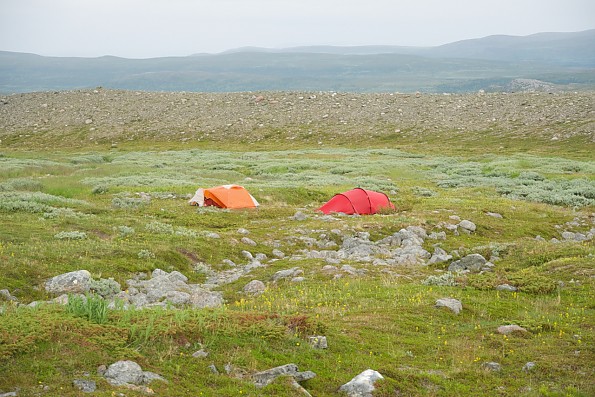
I try to avoid direct comparisons in reviews, but in this case I can’t help but compare with the Big Agnes Copper Hotel HV2 that we have been using since I reviewed it for the TS Review Corps in 2017, including on the 450 km Kungsleden in Sweden and a couple multiday hikes in Iceland. It has dual side entries, one with a gigantic vestibule, with great interior volume, slightly more interior and vestibule area, and it is turtle-able, but the floor and zippers are a bit fragile and it is designed to pitch inner tent first, all at about the same weight as the Anjan 2 GT. The first edition that I reviewed had a mostly mesh inner tent, not so great in wind, but the more recent model has replaced some mesh with ripstop. It easily converts from a half-open stargazer mode to fully enclosed, even with the vestibule in place. A Hotel made of the same materials as the Hilleberg Yellow Label tents and with less mesh on the inner tent and some kind of fly-first option might be the best of both worlds (but would likely weigh more).
The Anjan and other tunnel tents, especially those with an extended vestibule, are a great choice for trips in open, windy, and often rainy terrain. Given the tradeoffs of living in a tunnel tent, a freestanding, dual entry tent like the Copper Spur, with or without the giant Hotel vestibule, or the many similar tents from MSR or Nemo (to name just two) might be a better choice in more benign environments.
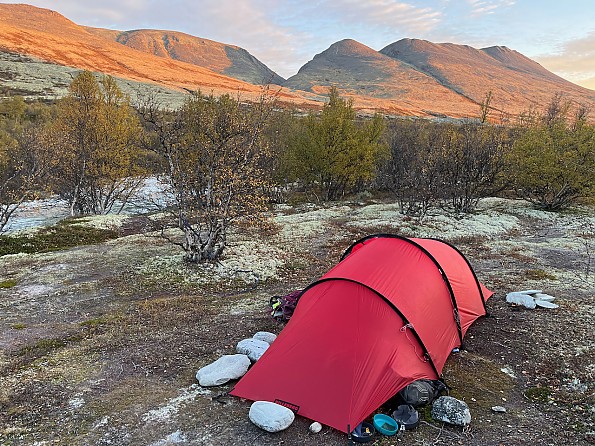
Background
Over 50+ years of outdoor life I have used dozens of tents, ranging from a cheap pup tent to classics like the Oval Intention, in environments ranging from tropical rain forest to arctic tundra. We have used the Anjan 2 GT for about a dozen nights so far, in cool, windy, and sometimes rainy weather in Norway and in hot, dry weather in the Pacific Northwest.
Source: bought it new
Price Paid: About NOK 8000 ($800) including 25% VAT
A tent with a very large porch, considering it only weighs 2.1 kg. Great for hikers and cyclists alike!
Pros
- Easy to pitch so quick to put up with practice
- Very very light for the space you have to use
- Lots of options for venting in warmer weather, both ends roll open
- It all pitches as one or outer first as with most of the Hilleberg tents
Cons
- The high sides of the outer can cause problems in wet weather
- The Hilleberg ground sheet only covers the inner tent for this model, so I got a Nallo, which fits all but a centimetre at the foot end.
I got this tent after using a Terra Nova Voyager Superlite on a two-week trek in Scotland. The porch was too small and I was fed up of climbing over the rucksacks for a pee!
Amazing space in the porch! I used this tent in South Wales for four nights and it rained and rained, condensation was minimal. (I used tyvek as ground sheet which may have helped.) It kept use dry and helped to keep use warm during the bad weather for four nights.
You do have to be aware of the high sides of the outer and pitch it correctly or you will get damp in the tent if it rains, as I did the first time I used it! You need to lower the wind wood side or pitch end on the wind.
I would consider this or any of the Hilleberg Anjan tents for lightweight hiking/cycling in the UK over the summer months. It's a great tent. It would be ideal in warmer climates like France or even closer to the equator because of the excellent venting options you get with this tent.
Source: bought it new
Price Paid: 560
Your Review
Where to Buy
You May Like
Specs
| Price |
MSRP: $995.00 Current Retail: $1,065.00 Historic Range: $9.95-$1,065.00 |
| Minimum Weight |
1.9 kg / 4 lb 3 oz |
| Packed Weight |
2.2 kg / 4 lb 14 oz |
| Inner Tent Height |
100 cm / 39.4 in |
| Inner Tent Area |
2.6 m² / 28.0 ft² |
| Vestibule Area |
2.5 m² / 26.9 ft² |
| Outer tent fabric |
Kerlon 1000 |
| Poles (9 mm) |
1x 305 cm/120.1 in / 2x 260 cm/102.4 in |
| Pegs |
16 Y-Peg UL |
| Packed Size |
46 x 14 cm / 18.1 x 5.5 in |


